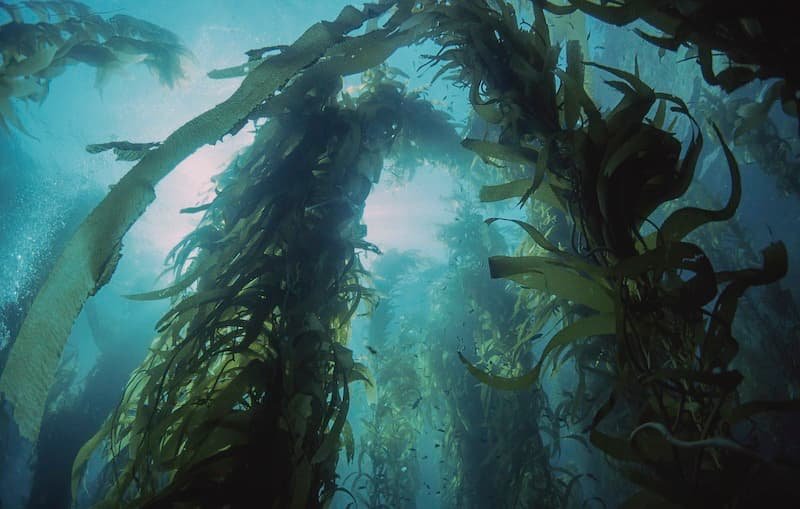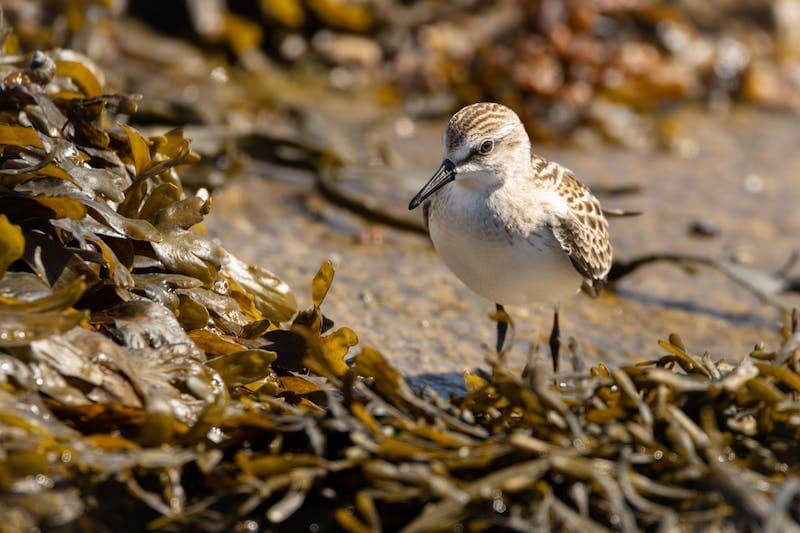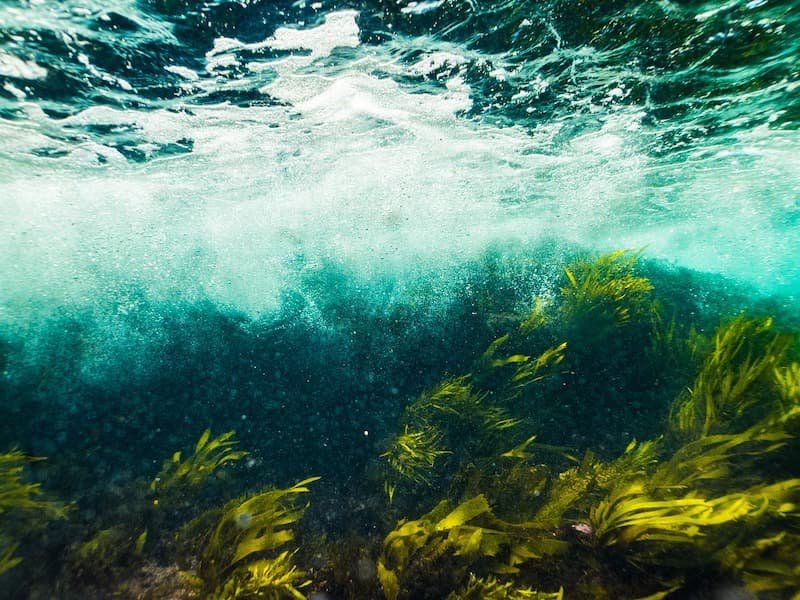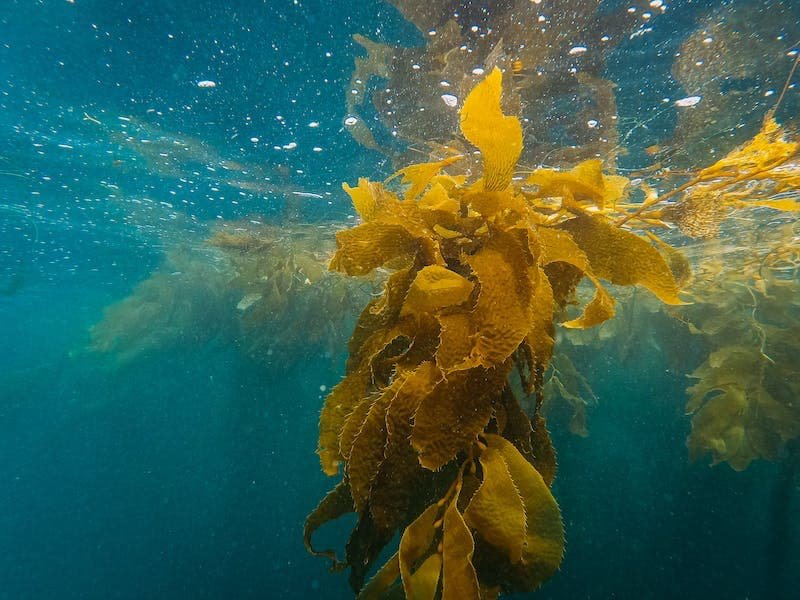
 Olivia Møller
Freediver - Activist - Explorer
Olivia Møller
Freediver - Activist - Explorer

 Olivia Møller
Freediver - Activist - Explorer
Olivia Møller
Freediver - Activist - Explorer
The world is facing unprecedented challenges due to climate change, and scientists are exploring innovative solutions to mitigate its impact. In the depths of our oceans lies a powerful ally in the fight against climate change: kelp forests. These underwater ecosystems, often overlooked, hold untapped potential that could play a crucial role in sequestering carbon and preserving biodiversity.
In the intricate dance of environmental conservation and climate change mitigation, kelp forests emerge as unsung heroes, wielding a unique power – the ability to sequester carbon with unparalleled efficiency.
Kelp's Carbon-Capturing Prowess: Recent studies have shed light on the remarkable prowess of kelp in absorbing carbon dioxide from the atmosphere. Astonishingly, these underwater giants are approximately 20 times more efficient than their terrestrial counterparts in this vital ecological task. Through the process of photosynthesis, kelp absorbs CO2, converting it into organic matter. This organic matter then descends to the ocean floor, effectively removing carbon from the atmosphere and storing it in the depths of the ocean.
Blue Carbon Sequestration: This phenomenon, known as blue carbon sequestration, not only positions kelp as a crucial player in the global carbon cycle but also showcases its potential to combat climate change on a significant scale. The ability of kelp to capture and store carbon far exceeds that of many other ecosystems, making it a powerful ally in the ongoing battle against rising greenhouse gas levels.
Crucial Findings and Global Implications: Until recently, the scientific community underestimated the magnitude of kelp's role in carbon sequestration. A pivotal 2016 study by Krause-Jensen and her colleague from the University of Copenhagen shattered these preconceptions. This groundbreaking research illuminated the substantial carbon sequestration capabilities of kelp forests, highlighting their superiority over other marine ecosystems such as coral reefs and mangroves. The data derived from such studies is invaluable for 'carbon accounting,' aiding global calculations of carbon storage in natural environments and enhancing the precision of climate models and carbon budgets.

In the complex tapestry of marine ecosystems, kelp forests stand out as vibrant hubs of biodiversity, playing a crucial role in preserving the delicate balance of underwater life. As we delve into the intricate web of connections within these submerged worlds, it becomes evident that the preservation of biodiversity is not just a goal but a necessity for the health and resilience of our oceans.
Kelp Forests as Ecosystem Pillars: Kelp forests, with their towering fronds and intricate underwater architecture, serve as foundational pillars within marine ecosystems. Their significance lies not only in their ability to sequester carbon but also in their role as sanctuaries for a multitude of marine species. These submerged havens provide shelter, breeding grounds, and abundant food resources for a diverse array of organisms, ranging from microscopic invertebrates to larger fish species.
Keystone Species and Ecosystem Stability: Labeling kelp as a keystone species underscores its pivotal position in the intricate dance of marine life. Without kelp, the delicate balance within these ecosystems would falter, leading to a cascade of detrimental effects. As demonstrated by a 2018 study from the University of California, ecologists Nyssa Silbiger and Cascade Sorte, seaweeds, particularly kelp, contribute significantly to rehabilitating their immediate environment. By elevating the pH level and reducing the acidity of seawater, kelp actively counters the adverse effects of ocean acidification, safeguarding the health of marine life dependent on these environments.

Nurturing Marine Life: Kelp forests serve as crucial nurseries for countless marine species. The complex structure of kelp provides a safe haven for the early stages of various fish and invertebrates, offering protection from predators and favorable conditions for growth. The presence of kelp thus becomes integral to the life cycles of many commercially important fish species, emphasizing the interconnectedness between the health of kelp forests and the prosperity of fisheries.
Enhancing Ecosystem Resilience: The preservation of biodiversity within kelp forests contributes to the overall resilience of marine ecosystems. A diverse array of species provides a built-in defense mechanism against environmental fluctuations and disturbances. This resilience becomes increasingly vital in the face of climate change, where the ability of ecosystems to adapt and recover is directly linked to the richness of their biodiversity.
Human Dependence and Ethical Stewardship: Recognizing the intricate relationship between kelp forests and human livelihoods further underscores the importance of preserving biodiversity. Coastal communities often depend on fisheries supported by these ecosystems, and the decline of kelp forests could have far-reaching consequences for both marine life and those reliant on it. Ethical stewardship, therefore, becomes paramount, necessitating sustainable practices that ensure the continued health and vitality of kelp forests.

In the intricate underwater realms of kelp forests, where marine life thrives in a delicate balance, ominous threats loom on the horizon, casting shadows over these vital ecosystems. The resilience of kelp forests, once considered impervious, is now being tested by an array of factors that pose significant challenges to their survival. Understanding these threats is crucial to charting a course toward effective conservation and sustainable management.
Rising Sea Temperatures: One of the foremost threats to kelp forests is the warming of the oceans. As climate change accelerates, the rise in sea temperatures takes a toll on the health of kelp. Kelp species are highly sensitive to temperature fluctuations, and prolonged exposure to elevated temperatures can lead to stress, reduced growth, and even the collapse of entire kelp ecosystems. The warming waters also create favorable conditions for the proliferation of certain herbivores that graze on kelp, exacerbating the threat.
Pollution and Runoff: Pollution, originating from various sources such as agricultural runoff, industrial discharge, and coastal development, poses a significant risk to kelp ecosystems. Runoff carrying excess nutrients like nitrogen and phosphorus can trigger algal blooms, blocking sunlight and impeding the growth of kelp. Additionally, pollutants can directly harm kelp by disrupting their physiological processes, making them more susceptible to diseases and other stressors.

Overfishing and Harvesting: The delicate balance within kelp forests is further disrupted by overfishing and excessive harvesting. Certain species, such as sea urchins, thrive in the absence of their natural predators, which are often targeted by fishing activities. Without these predators to keep them in check, sea urchin populations can explode, leading to overgrazing on kelp. Indiscriminate harvesting of kelp for commercial purposes also poses a threat, particularly when not carried out sustainably.
Ocean Acidification: The ongoing process of ocean acidification, driven by the absorption of excess atmospheric carbon dioxide by the oceans, has profound implications for kelp forests. Acidification weakens the structural integrity of kelp and impedes their ability to absorb calcium carbonate, a crucial component for growth. This process not only hampers the overall health of kelp but also has cascading effects on the entire ecosystem, affecting species that rely on kelp for habitat and sustenance.
Climate-Induced Storms and Disturbances: The intensification of climate-induced storms and disturbances, including hurricanes and cyclones, poses a direct physical threat to kelp forests. These extreme weather events can uproot or break kelp, leading to the loss of habitat and reduced structural complexity. Such disturbances not only impact the immediate health of kelp but also create challenges for the recovery and regeneration of these ecosystems.

Beyond their ecological significance, kelp forests hold a treasure trove of untapped economic potential, paving the way for a sustainable and innovative blue economy. As the world grapples with the need for alternative and eco-friendly solutions, harnessing the economic benefits of kelp cultivation emerges as a promising avenue that not only supports livelihoods but also contributes to the broader goals of environmental conservation.
Seaweed Cultivation for Biofuel Production: Kelp stands at the forefront of the biofuel revolution. Its fast growth rate and high carbon sequestration capabilities make it an ideal candidate for biofuel production. Seaweed cultivation for bioenergy not only provides a renewable and low-impact alternative to traditional fossil fuels but also mitigates climate change by sequestering carbon dioxide during the cultivation process. This dual benefit positions kelp as a key player in the transition towards a greener energy landscape.
Seaweed-Based Products: The versatility of kelp extends to the realm of product development. Seaweed, with its rich nutritional profile and unique properties, serves as a valuable resource for the production of a wide range of products. From food and pharmaceuticals to cosmetics and bioplastics, the applications of kelp-derived ingredients are diverse. The cultivation and commercialization of seaweed-based products not only offer economic opportunities but also promote sustainable consumption practices, aligning with the growing demand for eco-friendly alternatives.

Sustainable Aquaculture Practices: Kelp's role in aquaculture adds another dimension to its economic potential. Seaweed acts as a natural nutrient filter, absorbing excess nitrogen and phosphorus from the water, creating a healthier environment for fish and shellfish. Integrating kelp cultivation into aquaculture systems promotes sustainable practices by reducing the need for synthetic additives and enhancing overall system resilience. This symbiotic relationship between kelp and aquaculture exemplifies the potential for innovative and environmentally conscious approaches in the seafood industry.
Coastal Tourism and Recreation: Preserving and restoring kelp forests can also have positive economic implications for coastal communities reliant on tourism. Healthy kelp ecosystems create thriving underwater landscapes that attract divers, snorkelers, and ecotourists. The aesthetic appeal and biodiversity of kelp forests enhance the recreational value of coastal areas, creating economic opportunities through marine tourism. Protecting these ecosystems not only sustains biodiversity but also supports local economies by drawing visitors to explore and appreciate the underwater wonders of kelp forests.
Job Creation and Sustainable Practices: Investing in kelp cultivation and related industries contributes to job creation in coastal regions. From seaweed farmers to processing and manufacturing jobs, the economic impact ripples through various sectors. Moreover, embracing sustainable practices in kelp cultivation ensures the longevity of economic benefits while minimizing environmental impact. This emphasis on sustainability aligns with global initiatives for responsible resource management and reinforces the idea that economic growth can coexist harmoniously with ecological conservation.

Kelp forests represent an often-overlooked solution to the pressing challenges of climate change. Their ability to sequester carbon, preserve biodiversity, and offer economic opportunities makes them a powerful ally in our quest for a sustainable future. It is imperative that we recognize the importance of these underwater ecosystems, take steps to protect and restore them, and explore their full potential as a tool to combat climate change. By doing so, we not only safeguard our oceans but also harness the untapped power of kelp forests to tackle one of the greatest threats to our planet.